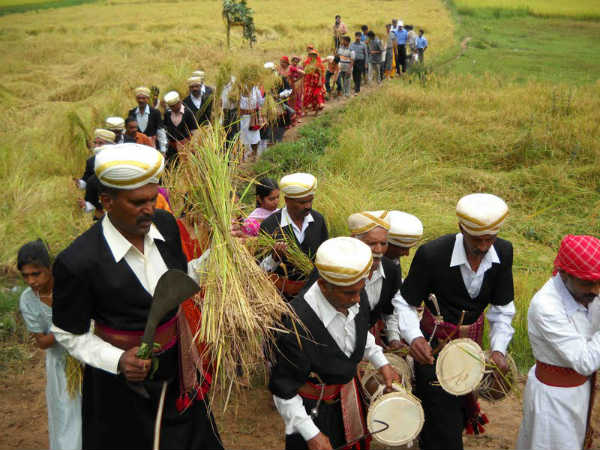Huttari
The traditional harvest festival of the Coorgs is called Puttari. Late
in the month of November or early in December just a few day before it is time
for the festival, when the crops are ready for harvest and the moon is full,
every village and every family come together and pray to the gods, thanking
them for another plentiful year. Then the lady of the house takes a lamp and
leads everyone to the fields and the first of the ripe paddy are cut. The
sheaves that are cut are tied in little bunches and passed out to the
attendants of the festival. The bunches are hung over the threshold or other
significant place to ensure prosperity.
The house and its
surroundings are cleaned, buildings are whitewashed and doorways are decorated
with a string of mango leaves and marigold on the festival day. After a bath,
the person designated to cut the first paddy stalks dressed in white kupya( traditional
Coorg dress for men) prepares the mat on the threshing floor, and supervises
the preparation of the nere which is a collection of leaves from a particular
tree which is rolled and tied together. The lady of the house fills the Huttari
basket with paddy, some rice and rice flour. Close to it is a kutti(vessel made
with hollow bamboo) with milk, honey, ghee, sesame seeds etc. A sickle is also
placed with this. A mukkali (three legged stool) with the bolcha (lamp) and a
plate with rice, betel leaves and areca is also kept. A basket with puffed rice
and honey is also sent to the fields.
Women take a large dish
full of rice and place a lighted lamp on it. This is carried by an unmarried
girl, who goes ahead of the family members to the fields. The head of the
family follows carrying a basket with honey and milk and the sickle. He pours
the milk at the base of the paddy plant and all shout ‘Poli, Poli Deva!’
(Shower, Shower O God! Asking for a good harvest) The person with the kutti,
ties the nere to the base of the paddy cluster. A single gun shot is fired in
the air. The paddy sheaves are cut in odd numbers 5, 7, 9, 11 and placed in the
kutti (basket). He also distributes it to those present. All return to the
threshing area shouting Poli,Poli Deva . Stalks of rice are placed in the
threshing area. At the entrance of the house they are welcomed by an unmarried
girl who washes the feet of the kutti carrier and gives him some milk to drink.
The man with the kutti, takes elders’ blessings by touching their feet. Elakki
puttu (steamed rice preparation) with rice flour, sesame, ginger, coconut,
bitter gourd skin, etc., is prepared. Bananas, milk, honey are added and little
balls are made and placed on pipal leaves. The puttu is then served with other
dishes like Thambutt (made with bananas, rice flour, coconut scraping, sesame
seeds) and sweet rice payasa ( milk, sugar preparation with the new rice).
Meedi (food offering
kept for one’s ancestors) is an important part of the celebration. All the
cooked dishes are first kept for the ancestors. Bursting of firecrackers form
an important part of the celebration.
There are many types of
kol (stick) dances performed during Huttari. At the end of the dance is “Pariya
Kali” (Dance of the Shields). Nowadays, sticks are used instead of shields. The
dancers in pairs, strike each other below the knees. The spectators stop the
dance if one member is stronger than the other. After three rounds they stop
and embrace each other.
The festival brings together the village folk, and is a sort of thanksgiving for the bounty that has been received.




Comments
Post a Comment